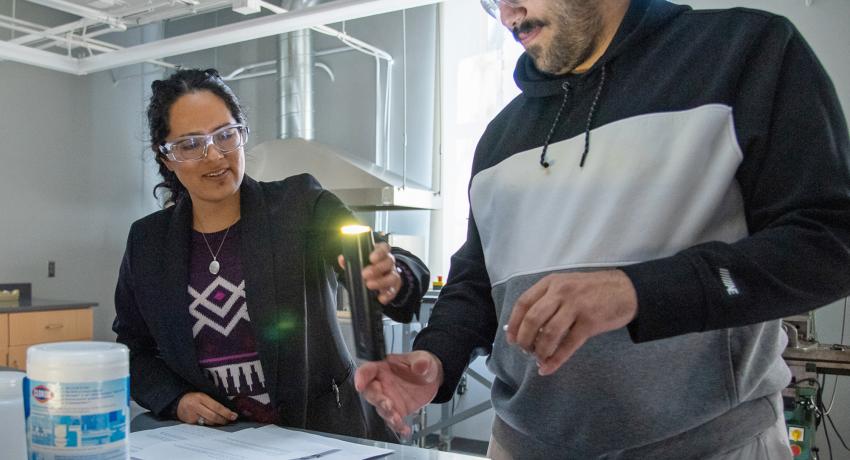Lourdes Bobbio, assistant teaching professor in the Department of Materials Science and Engineering, teaches an undergraduate student how to work safely in the lab. Goals of safety and discovery are two hallmarks of the major. Credit: David Kubarek / Penn State.
By David Kubarek
UNIVERSITY PARK, Pa. — In the vast and varied research that comes out of the Department of Materials Science and Engineering (MatSE) at Penn State, there’s one thing that’s even more important than discovery: lab safety.
Making the department a leader in laboratory safety has been a focus since the mid-2000s with the creation of the MatSE Safety Awareness Organization. Since then, the group has been working with faculty, staff, students and industry partners to keep labs safe while ensuring students enter the workforce with stellar safety practices.
Elizabeth “Libby” Kupp, a longtime member of the safety organization, said the group started with low-hanging fruit, such as enforcing safety glasses and appropriate attire but since then expanded efforts with dedicated lab safety officers and input from industry partners. Kupp, who earned her undergraduate and doctoral degrees from Penn State, retired as an associate teaching professor from Penn State in 2022. As an instructor, she imparted her passion for safety to her students and, to support the department’s continued advancement, she recently established the MatSE Safety Fund.
“The health of our students, faculty and staff is of utmost importance,” Kupp said. “Teaching our researchers, especially students, how to work safely in the laboratory is a keystone of their education. I see safety education as vital to the success of our students as they graduate and become professionals in the materials community.”
Kupp made several efforts to improve lab safety as a member of the group. She stressed her efforts were part of a larger effort led by faculty and staff, including MatSE facilities representative Scott Henninger. Also integral, she said, were Gary Messing, Distinguished Professor Emeritus of Ceramic Science and Engineering, who began formal lab safety efforts, and Susan Sinnott, head of MatSE, who invested heavily in improving lab safety training.
Kupp developed and taught a laboratory management course for graduate students in collaboration with Sarah Eichfeld, the safety officer at the Materials Research Institute.
“The course helped us unify the safety message across the entire materials community at Penn State and reach more than just MatSE students because the students working at the Millennium Science Complex are enrolled in a broad spectrum of science and engineering majors,” Kupp said.
Her efforts also included:
- Organizing the graduate student laboratory safety managers group. These students, appointed by the faculty leads in each lab, are responsible for getting the word out on lab safety practices and are also tasked with performing inspections.
- Working with colleagues at other universities and national labs to organize and run safety symposia at Materials Science and Technology conferences and a tutorial at a Materials Research Society conference.
- Weing part of the team that developed the MatSE Safety Award, awarded at the department’s annual student awards banquet. It recognizes students who are leaders in advancing laboratory safety.
- Incorporating safety into all undergraduate laboratory courses, which accounts for 10% of the grade.
Kupp said employers demand students leave with a focus on safety.
“Our alumni stress how integral safety is to everything they do in industry,” Kupp said. “If our students take on safety as a value in their professional lives, they have an advantage over their colleagues from other schools. I’ve heard from students who return from internships that they appreciate the safety education they received in their courses and research experiences in the department because of the emphasis put on safety where they interned.”
Ryan Dirkx, who earned his doctorate from Penn State in 1985, is one of the MatSE alumni helping to improve lab safety at Penn State. Dirkx retired as vice president of research and development at Arkema Inc. and serves on MatSE’s external advisory board.
“Safety leadership has become an important criterion as industry evaluates candidates to hire. Thanks to the efforts of the MatSE department, their students have plenty of opportunity to engage in safety initiatives at both the graduate and undergraduate level,” said Dirkx, who now works as an adviser for R&D Excellence Advisors. “This addition to their resume helps to further differentiate them in the employment marketplace.”
Gifts to the MatSE Safety Fund will advance the University’s historic land-grant mission to serve and lead. Through philanthropy, alumni and friends are helping students to join the Penn State family and prepare for lifelong success; driving research, outreach and economic development that grow our shared strength and readiness for the future; and increasing the University’s impact for families, patients, and communities across the Commonwealth and around the world. Learn more by visiting raise.psu.edu.

